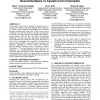Free Online Productivity Tools
i2Speak
i2Symbol
i2OCR
iTex2Img
iWeb2Print
iWeb2Shot
i2Type
iPdf2Split
iPdf2Merge
i2Bopomofo
i2Arabic
i2Style
i2Image
i2PDF
iLatex2Rtf
Sci2ools
PETRA
2009
ACM
2009
ACM
Carbon nanotube coated high-throughput neurointerfaces in assistive environments
Loosing motor activity due to impaired or damaged nerves or muscles affects millions of people world-wide. The resulting lack of mobility and/or impaired communication bears enormous personal, economical and social costs. While several assistive technologies exist, they rely on device surrogates to compensate for the lack of movement and thus provide limited utility and unnatural interface with the user. The ability of interfacing populations of neurons with super high-density multielectrode arrays (SD-MEA) can provide the sensing from and control of bionics devices by thought. Here we propose a neurointerfacing approach using SD-MEAs coated with carbon nanotubes and high-speed computing to overcome latency and long-term electrical viability bottlenecks that are essential in assistive environments. The proposed approach provides ability for fast integration of recording/stimulation from thousands of individually addressable electrodes, while coordinating a real-time computing approach...
Carbon Nanotubes | Emerging Technology | Muscles Affects Millions | PETRA 2009 | Real-time Computing Approach |
| Added | 28 May 2010 |
| Updated | 28 May 2010 |
| Type | Conference |
| Year | 2009 |
| Where | PETRA |
| Authors | Mario I. Romero-Ortega, Ali Raza Butt, Samir M. Iqbal |
Comments (0)

